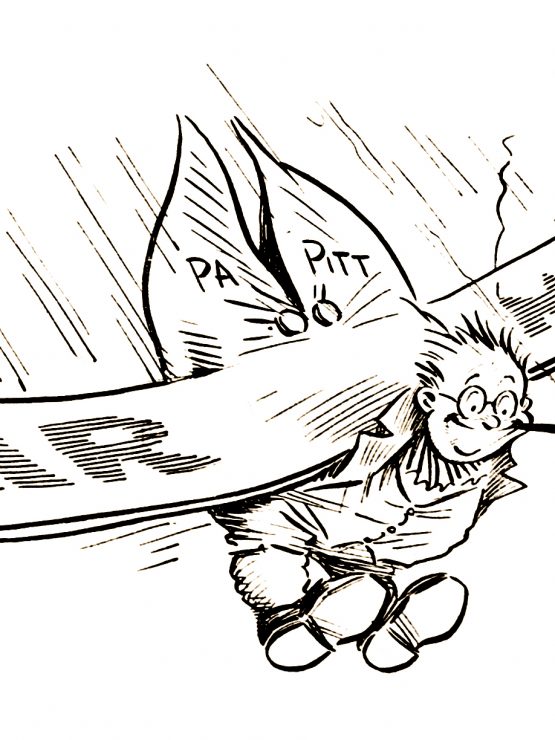Editorial cartoonists in the 1920s and ’30s chronicled the Golden Age of Aviation as the public scrambled to adapt to a newly air-minded world. Newspaper editorial cartoons had offered visual commentary, criticism, and perspectives for centuries, so advancements in aviation were natural subjects for beloved Pittsburgh cartoonist Cy Hungerford. His daily cartoons for the Pittsburgh Sun and Pittsburgh Post-Gazette entertained and informed from 1912 until he retired in 1977.
The History Center’s Detre Library & Archives is home to an expansive collection that chronicles Hungerford’s career, including letters from public figures whom he featured in his cartoons. According to an article published in the April 1983 issue of Western Pennsylvania History,1 Hungerford’s style fit within the Humanist tradition of editorial cartooning — espousing hope and optimism, focusing on growth and change, and skewering frustrations with gentle irony and humor.
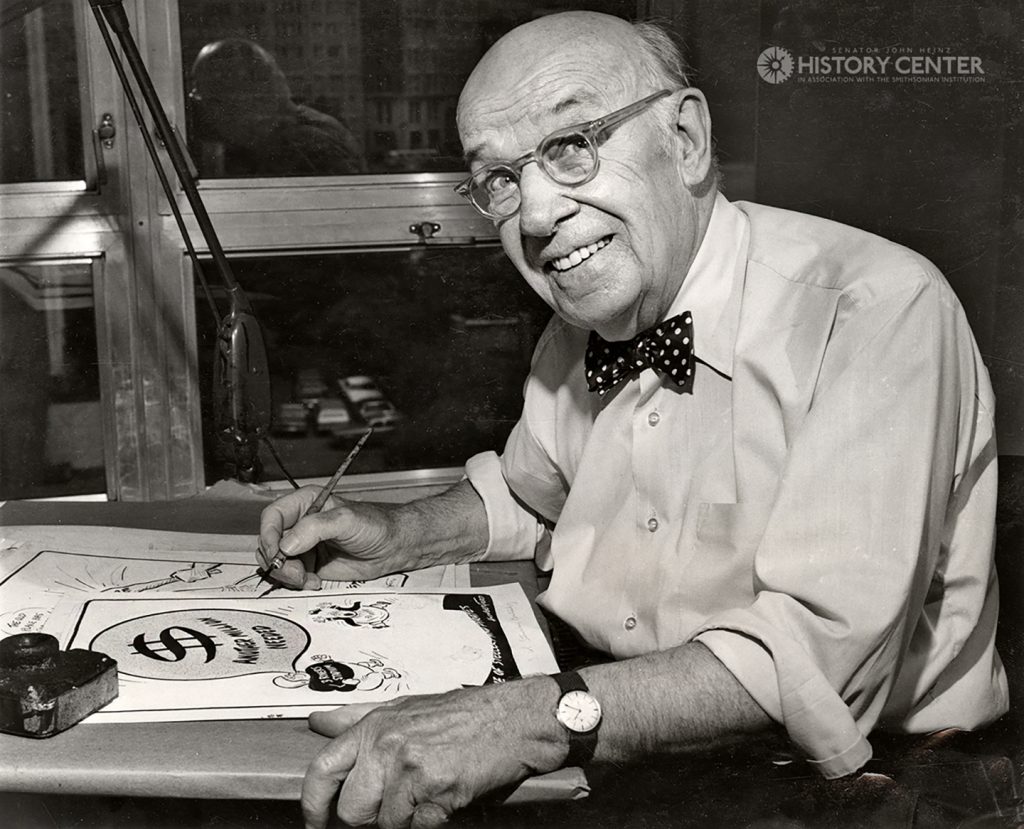
Cy Hungerford, 1942. Cy Hungerford Collection, MSP194.B001.F009.I01.
Hungerford kept his eyes on skies near and far. When Amelia Earhart completed the first solo, nonstop flight from Hawaii to the U.S. mainland in 1935, Hungerford’s portrayal — which teased the era’s male pilots — was widely reproduced. It so tickled Earhart and her publicist husband that they wrote to Hungerford requesting the original.2
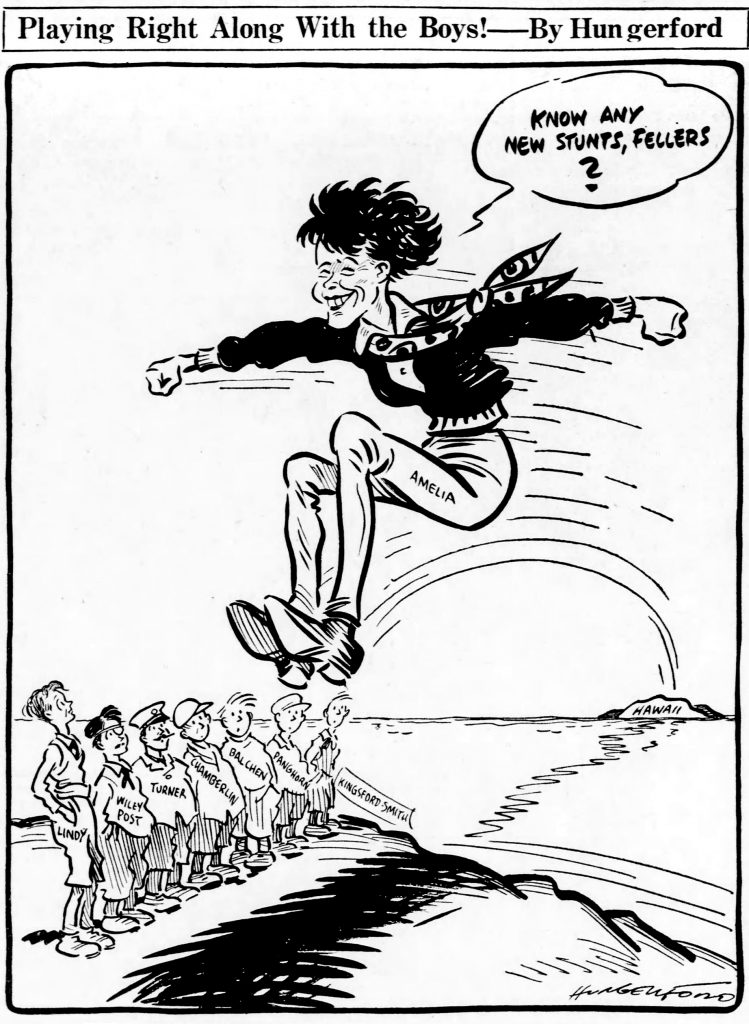
“Playing Right Along With The Boys!” Jan. 14, 1935. Pittsburgh Post-Gazette.
A few days after Earhart’s disappearance over the Pacific in July 1937, Hungerford poignantly portrayed the desperation that characterized ongoing searches for the famed aviatrix.
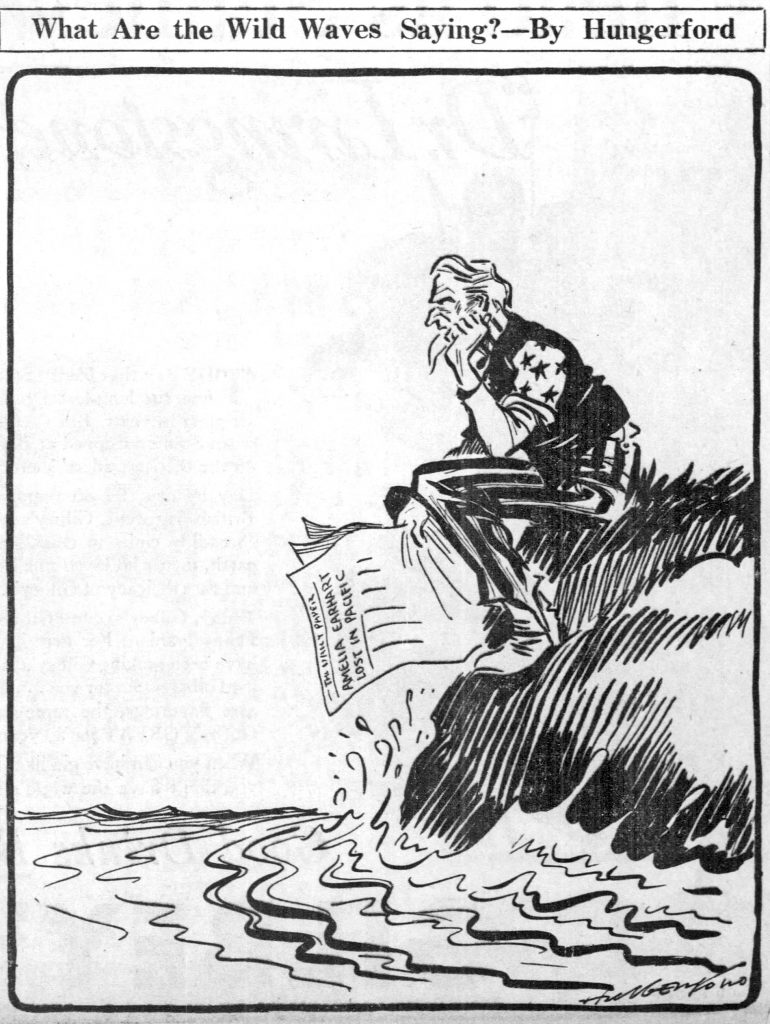
“What Are The Wild Waves Saying?” July 6, 1937. Pittsburgh Post-Gazette.
Hungerford is perhaps best remembered locally for his rendition of “Pa Pitt,” a character who had graced Pittsburgh newspapers since the 1890s. Hungerford’s portly colonial gentleman offered endearingly bemused observations that resonated with readers. Pa Pitt chronicled local aviation development, offering political insight while channeling the wonder and awe that the average Pittsburgher felt about the air-minded age.
In 1925, Rodgers Field in Aspinwall/O’Hara opened as a federally controlled, municipally developed airport to foster local commercial aviation. The city and county had controversially invested $80,000 to acquire the 40-acre McRoberts Farm for the project. In this cartoon, a dismayed Pa Pitt ponders a biplane representing U.S. airmail leaving Rodgers, flying from the “empty cage” of McRoberts Farm to wing its way toward McKeesport. That’s where a new, privately developed airport named Bettis Field would become the home base for Pittsburgh’s lucrative federal airmail contract. Rodgers Field indeed became an obsolete “empty cage” within a decade.
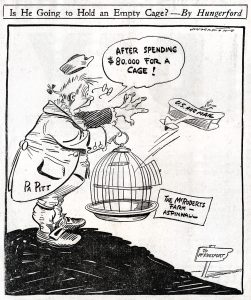
“Is He Going To Hold An Empty Cage?” c. Jan. 1926. The Pittsburgh Sun via Clifford Ball papers, MSS12.B001.F005.I03.
In this next cartoon, Pa Pitt soared, clasped in the grip of national “aviation enthusiasm” and an American eagle. The bird referenced Colonel Charles Lindbergh’s nickname, “The Lone Eagle,” which was earned following his completion of the world’s first solo, nonstop, transatlantic flight in The Spirit of St. Louis in May 1927. Lindbergh visited Pittsburgh on August 3–4, 1927, during his subsequent cross-country victory tour in the plane. Hundreds of thousands of Pittsburghers celebrated, with newly converted aviation enthusiasts turning out to catch glimpses of Lindbergh flying at Bettis Field and other appearances.
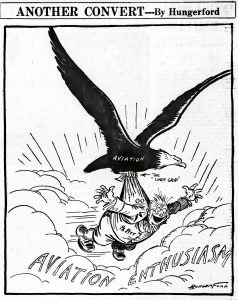
“Another Convert” Aug. 4, 1927. Pittsburgh Post-Gazette.
This cartoon graced the front of a 36-page newspaper special edition touting regional aviation development. A winged Pa Pitt symbolized confidence that new investments and organizers would play a vital and successful role in “hatching” Pittsburgh’s nascent aviation industry.
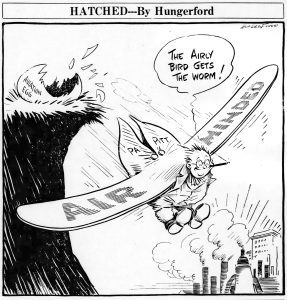
“Hatched” Sept. 23, 1929. Pittsburgh Post-Gazette.
Aviatrix Louise Thaden won the first Women’s Air Derby, a transcontinental race from California to Cleveland, Ohio, at the National Air Races, in September 1929. Thaden, who had recently moved to Pittsburgh, proudly represented her new city, which declared her its “adopted daughter of the skies.” The future of aviation was written large in the clouds by Thaden’s plane as Uncle Sam bore witness to Pittsburgh’s rising national profile, thanks to her accomplishment.

“The Sky Writer” Sept. 27, 1929. Pittsburgh Post-Gazette.
Levelling some 3 million cubic yards of hilly terrain in West Mifflin to create Allegheny County Airport in 1930 was literal “dirty business” and undertaken at considerable cost ($3.5 million, nearly $59 million today). County Commissioner Charles McGovern — caricatured here as “Mickey (Himself) McGovern” for both his Irish heritage and pugnacious fiscal watchdog stance — called for strict oversight and transparency, which was viewed as intrusive “dirty business” by some.
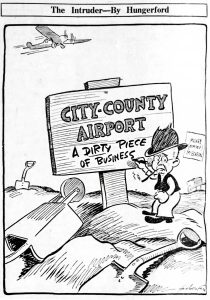
“The Intruder” Aug. 19, 1930. Pittsburgh Post-Gazette.
When it was dedicated on Sept. 11, 1931, the new Pittsburgh-Allegheny County Municipal Airport in West Mifflin encompassed 432 acres and utilized the latest aviation technology, prompting the Post-Gazette to declare that it was “among the great flying fields of the country.” Hungerford portrayed civic pride with an appearance by Ma Pitt, sporting an elaborate “City-County Airport” feather in her aviation cap. Meanwhile, Uncle Sam gazed in wonder at Pittsburgh’s latest addition to national aviation.
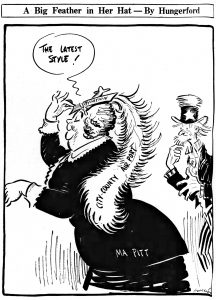
“A Big Feather in Her Hat” Sept. 11, 1931. Pittsburgh Post-Gazette.
About the Authors
Brian Butko is the director of publications at the Heinz History Center.
Sue Morris is a regional public historian who has been writing and lecturing as The Historical Dilettante for the last decade about unexplored 19th and 20th century Pittsburgh.
Butko and Morris are the authors of “Bettis: Where Pittsburgh Aviation Took Off.”
1 Giovengo, Annette. “Historical Society Notes and Documents: The Hungerford Collection.” Western Pennsylvania Historical Magazine (April 1983): 183-199.
2 The Papers of Cy Hungerford, MSS#194; Detre Library & Archives, Senator John Heinz History Center; Series II: Correspondence, 1915-1978, Folder 35.

